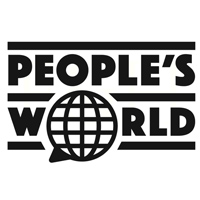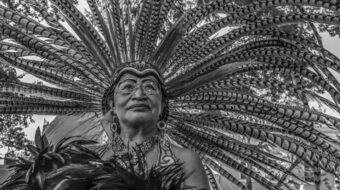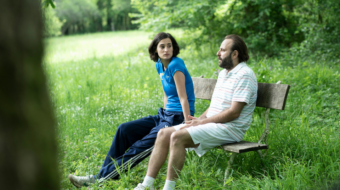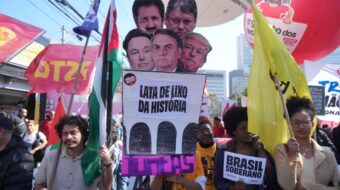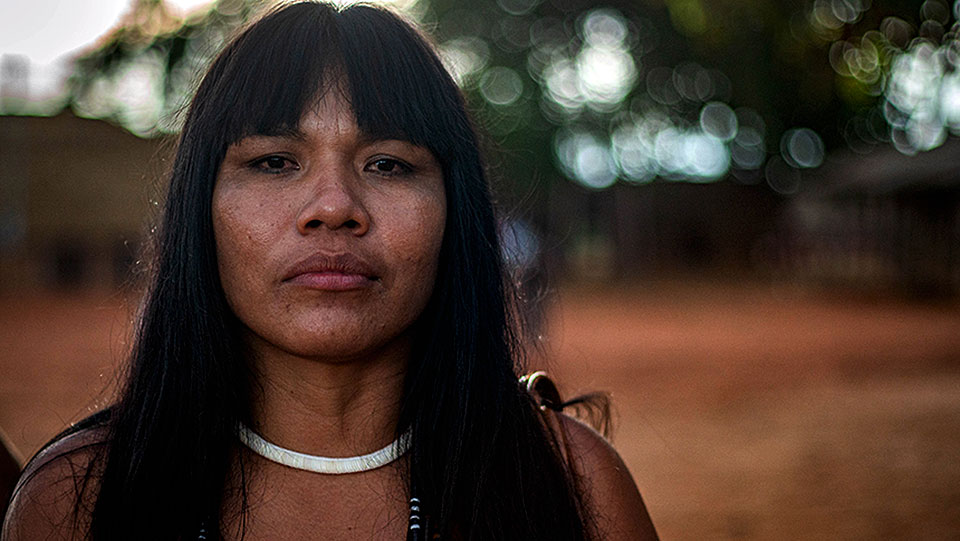
The women’s leader of the Xingu Indigenous Territory, the eldest daughter of one important tribal chief and the niece of another, Watatakalu Yawalapiti watched her family be devastated by Covid. Eight relatives succumbed to the disease, including her mother, medicine woman Iamoni Mehinako, and her uncle, chief Aritana Yawalapiti, the historic leader of the peoples of the Upper Xingu, in the state of Mato Grosso. “Our people were orphaned,” the forty-year-old artist and activist declares. Watatakalu is the general coordinator of the department of women of the Xingu Indigenous Land Association (ATIX-Mulher).
In the following account, Watatakalu recalls the pain of the loss and describes how the disinformation campaign and the federal government’s mismanagement of the pandemic allowed the virus to spread through the Indigenous areas. Up until March, according to data gathered by the Special Xingu Indigenous Sanitary District (DSEI Xingu), 1894 Covid cases and 21 deaths caused by the virus were recorded, 16 of these in the Upper Xingu where Watatakalu’s family lives.
(This testimony was recorded by Bruno Weis and Sília Moan, of the Socioenvironmental Institute.)
PIAUI — My mother, the medicine woman Iamoni Mehinako, was one of the women’s leaders of the Mehinako people, one of 16 ethnic groups that live in the Xingu Indigenous Territory (better known as the Xingu Indigenous Park), in North Mato Grosso. Created in 1961, the XIT was the first large Indigenous area defined by the federal government, consisting of 26,000 square kilometers, currently home to more than 6,000 Indigenous people. While still very young, Iamoni married my father, tribal chief Pirakumã Yawalapiti and went to live in his village.
My mother made a point of teaching me and my sister, Ana Terra, the traditions of the ancestors. We are the descendants of four ethnic groups: our grandmother was Kamayurá, our great-grandmother was Wauja, and our grandparents, the parents of our father and our mother, were Mehinako and Yawalapiti. We have family members in every village of these four peoples. We learned from her that we had to care for our relatives, take them into our home, not just say: “That guy there is my cousin.”
My mother got up early to cook. Ours was traditional food, not rice and beans. There was always pequi porridge in the house. “Iamoni is going to make tucunaré [a popular fish] with pequi nuts,” meant they were going to have a feast. These are things that were already uncommon in the day-to-day lives of our people, so they attracted many people. “You have to share food with everyone. In our culture that is the way it is: when the leader has something, he must share it with his people,” she taught us. My father’s first cousins, who are Xingu chiefs, lived in our house. That’s why I know them all.
At night, my mother told stories in the Indigenous language. “The white people have their documents. We have our language and our culture. You are going to learn Portuguese, but at home, we are going to speak in our language,” she said. I learned the songs from her. “There is going to be a Kuarup [a Xinguan ritual in honor of the dead] and you are going to represent us.” Sometimes, I would go against the traditions. When I was 15 years old, I did not accept an arranged marriage. I chose my husband, Ianukulá Kaiabi Suiá, myself.
When the Covid pandemic was declared, in March 2020, I was quarantined because I had just returned from Belgium, where I received an award from a feminist women’s collective. My mother called me to ask: “They say that the disease has come to Brazil, what must I do?” “Stay where you are. Do not go to visit Ana because we don’t know what is happening where she lives,” I replied. Ana, my sister, lives with her husband and her children in the Yawalapiti village. My mother went back to live with the Mehinako people after my father died in 2015. Covid came into the Xingu territory at the end of May 2020, in the Culuene River region, and the first bulletin with confirmed cases came out in June. In July 2020, Ana caught the disease. She had spent time with my mother among the Mehinako people, but they pressured her to return to the Yawalapiti village and stay with her husband. At that time, there were already Covid cases there, but they convinced her to return anyway: the flu is not strong, everyone here has had it, you can come.”
When she did, Ana was infected with coronavirus. She was treated with chloroquine—a medicine proven to be ineffective against Covid—by the indigenous health teams from the Leonardo Villas Boas Basecamp in the Upper Xingu region. “I was speaking out against chloroquine on the social sites and they were giving me chloroquine without my knowing it,” my sister told me. Her condition was getting worse and I was beginning to despair. It got to the point where 80% of her lung capacity was compromised and her heart stopped twice. Our parents were taken to the city to receive medical treatment and died. There was a day when I heard the noise of an airplane taking my uncle’s body and I was scared that my sister would be next. People said: “Ana won’t make it through the day.” Some of our relatives got in touch with my mother and said: “You are a medicine woman. You have to come to take care of your daughter.” But I did not let her go because she could be infected. My uncle, chief Aritana Yawalapiti, died from complications of Covid on the 5th of August 2020. His death was a shock to all of us. It stopped the whole Xingu. Our people were orphaned. You know how a neglected puppy looks when it has lost its master? That is how I felt. When I told my mother, she began to weep. At that moment, the people in the villages understood that it was not “a little flu,” as the federal government claimed because various of our relatives were dying of the disease.
In August 2020, there was a suspected Covid case in the Mehinako village. That’s when we took my mother, my siblings, nieces, and nephews to the city of Canarana, Mato Grosso, close by the Xingu Indigenous Territory, where I live with my husband and my children. After a while, we brought my sister Ana as well. She was better, although still using an oxygen tube.
At the end of the year, we went to the Ytapap village. I wanted my mother to come with us but she preferred to remain in Canarana. She had high blood pressure and pains in her legs. “I’ll come to the village after my medical tests,” she said. Then she got pneumonia. She got better but preferred to stay in the city, in case she needed to see a doctor. She called one of her sisters and a niece to keep her company.
Vaccination began in the Xingu in February 2021. Days earlier we received news from the people of the Xingu DSEI (the Special Indigenous Sanitary District responsible for regional medical care) that only Indigenous people registered as living in the villages would be vaccinated. But many relatives live in the city, like me. My husband, Ianu, is president of the Xingu Indigenous Land Association (ATIX) and I am the general coordinator of the woman’s division of the same organization, ATIX-Mulher. We live in Canarana because it is close to the ATIX headquarters. But I was born and raised in the village and I am always coming back and forth from there. Before the vaccination began, we asked the DSEI health teams several times: “Do you need any help? Have you got all the information for the Indigenous registration? Because there are relatives on their way here.” They told us everything was okay. The moment I found out that people living in the city did not qualify to be vaccinated, I got upset: “Why can’t we be vaccinated as well?” I threatened to tie up all health workers until all the relatives received their first dose. Things became so unruly that the special secretary of Indigenous Health, Robson Santos da Silva, had to go there [fly from Brasília to Canarana] to check out what was happening.
My mother got her first dose of Corona Vac in February 2021 in Canarana. She forced the Xingu DSEI health tech to vaccinate her and was only able to get the second dose after 60 days—30 days late. Even then, only because she fought for it. My mother lived in the Mehinako village but she was staying for a while in Canarana to protect herself. She speaks Portuguese fluently and demanded that those responsible for the vaccine inject her with a second dose. Things were so messed up that they stopped responding to her messages. My uncles and the Indigenous health agent of the Mehinako village had to intervene. In the middle of April, she finally received her second dose. If she had been able to get it a month earlier, she might still be alive today.
At the end of April, I decided to go to Canarana to stay with my mother. That is when I learned that my aunt and her daughter, my cousin, were there. When mother told me this, I went nuts: “You cannot have anybody in your house!” She said: “I am trying to tell them they cannot leave.” The day before I met with her, I called her and said: “I’ll be there tomorrow.” She told me: “Better not come because I think I have the flu, my whole body feels bad.” I asked if she had had a Covid test. “I did but I won’t know the result for ten days,” was her answer. I told her to bug the Casai (Indigenous Health Clinic) people.
She said, “The Casai people don’t care about us. I keep calling, but they never get back to me.”
I got to Canarana on May 3rd. I spoke to my mother on Skype. She was trying to hide her constant coughing. That night, I asked my brother to measure her saturation level. It was 92. I was very worried. I spoke to the people at Casai and asked if she had had a CAT scan. She had not. I asked why not and they said that the DSEI does not have money for that. My mother told me they offered her chloroquine but that she refused and handed it back to them. I asked that they test her for Covid and the result came back positive. Until then, my mother was not sure she had Covid. I had another video call with her and said: “Mom, you have Covid. How are you feeling?” She told me: “I’m very bad. I’ve never felt anything like this.” I asked that they do a CAT scan and her lungs were completely congested. She had contact with a person with Covid symptoms on April 16th. At that point, she had been infected for more than two weeks. During all that time, they did not care for my mother or give her the right remedies. She got worse and was taken to a hospital in Querência, Minas Gerais. We managed to find an airborne ICU to take her to a hospital in São Paulo. But when she got to the airport, she began to turn purple and her heart stopped. The doctor asked my sister: “Do we take her there like this? You need to decide.” They took her back to the hospital in Querência and she stayed there another week. I had gotten Covid and was in Canarana. But I was able to visit her in the hospital in Querência. As I too had symptoms, they let me go. Those final moments were the most difficult ones. We opened a message group with her siblings and we all kept an eye on the medical bulletins. She was not able to survive because that hospital did not have the kind of care she required, it was very precarious. She was intubated in the ICU and died on May 25th.
We brought the body to our house in Canarana. When Ana opened the casket, she fell ill. She was dizzy and struggling to breathe and began to vomit. It was very disturbing to see our mother’s body full of syringes and needles. I was not ready to prepare her body for burial but she could not be interred looking like that. Normally, other people do this, but we couldn’t ask anyone to do it because of the risk of contamination. My sister and I both had Covid.
We bathed her, tidied her hair, and painted her face. We dressed her in a garment she liked, closed the casket, and brought it to the Mehinako village. By the time we arrived, the grave was ready. My mother was buried like a traditional leader. In our culture, to weep at the burial is a sign of respect, but we asked the relatives to stop because their lungs were debilitated. The entire village had Covid. “We will not be offended if you do not weep,” we explained.
Since the pandemic came to the Xingu territory, besides my mother, I lost two uncles, two female cousins, a great aunt, and another cousin’s husband to Covid. Eight people from my close family. During all of this time, the Indigenous health service abandoned us. When the FUNAI (the Brazilian National Indian Foundation) was created in the 1960s and after differentiated health at the end of the 1990s, the objective was to help the Indigenous peoples and that is not what is happening. Nothing we have now was given to us, we had to fight for it. Our ancestors won it with many struggles. FUNAI was a victory of my grandfather’s generation. The DSEI and the matter of differentiated health was from the time of our parents. My father took many white men inside our land so they could see how difficult the situation was and demand a response from the government.
It is very easy for the SESAI (Special Secretariat of Indigenous Health) to pay us a quick visit and then produce and broadcast a video saying: “We are doing this work.” But when our relatives say: “We need real medicine,” the SESAI does not provide it. The EPIs (equipment for individual protection), the face masks, the hand sanitizers, and the pills we received in the pandemic did not come from the SESAI. The current federal government is a threat to the lives of the Indigenous peoples. And this situation needs to change.
Translation for People’s World by Peter Lownds
From Folha de S. Paulo / Piauí


